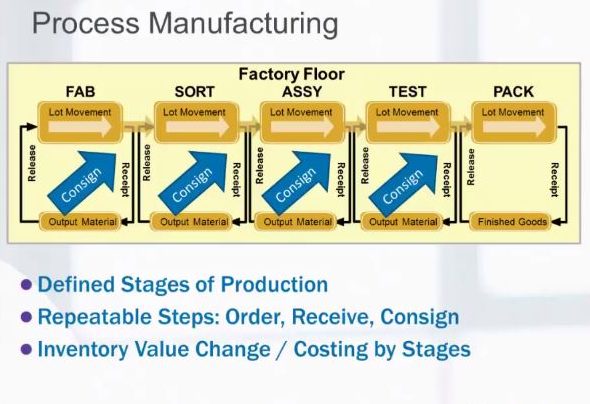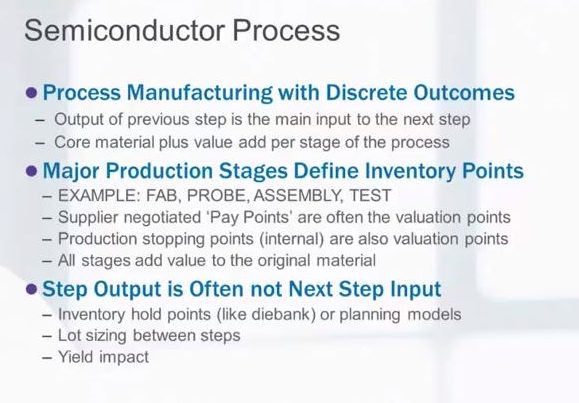 [The following is a partial transcription of the beginning of a recorded Tensoft SemiOps training webcast, which is available to anyone who’s interested – see video here.]
[The following is a partial transcription of the beginning of a recorded Tensoft SemiOps training webcast, which is available to anyone who’s interested – see video here.]
“While semiconductor manufacturing is a process, it also has fixed outcomes, which makes it unique. So it’s not really process manufacturing like food, oil and gas, or paint process manufacturing. It’s also not a continuous flow process. It is a process though, and has defined stages of production.
If semiconductor chip manufacturers look at their production stages, they normally can identify major and sub categories of steps of production. These might be defined by when inventory value changes, or by when you have a costing or payment step that you are providing your vendors, or some sort of a whole point. These are repeated steps in the process: 1) order; 2) receive; 3) consign to inventory; and 4) repeat 1-3.
 And so then this order (see graphic) is adding value to the consigned inventory from the preceding step. We consigned, we ordered to add value, we received that, we have new material, we consign that to the next step, we order, we add value, we have new output, and lastly, and consign that material to the next step. With each order-receive-consign cycle, we do a receipt or a production step.
And so then this order (see graphic) is adding value to the consigned inventory from the preceding step. We consigned, we ordered to add value, we received that, we have new material, we consign that to the next step, we order, we add value, we have new output, and lastly, and consign that material to the next step. With each order-receive-consign cycle, we do a receipt or a production step.
We have an inventory value change that occurs and those become the points in standard costs where we say: this is where we need a plan. We need a plan for what costs is going to be at each one of these stages. We need to consider how we’re going to value this inventory or this lot in process that we are going to consign to the next step. If you think about it from a financial perspective, we order, receive, and then we value. Then we consign the valued inventory to the next step, where we order, receive, value, and then consign that material to the next step of the process and so on.
So the semiconductor process is really process manufacturing with discrete outcomes. There are a few other industries with processes like it, although none of them quite like the technology industry. It’s unique in terms of this process flow – an inverted BOM (Bill of Materials) process flow. There’s a few things how process and discrete outcome play into it. One of them is the assumption that output of the previous step is the main input to the next step. So we have something where it consign material and something where we take it and add value to it as it goes. We put a wafer in and put it into inventory. It may not stay there very long in the model and it may go straight to the test. But the test process, maybe you don’t think of it as adding value, but a pro process really goes through and says we’re the good die and the bad die. And so in that particular way, it’s added value to at least you’re knowledge of what’s good about that wafer. The die that’s actually useful can take the cost of the wafer and the cost of the test step and allocate that to the good die and the wafer.
The next step is the assembly process. And that’s going to be something where we take it to a die saw, we take it to die attach, we do all these processes for assembly. But really, the output of the preceding step is often the main input to the next step. We really are focused on this core material plus value add at each stage of the process. If you are doing an external manufacturing, if you’re using a supply chain, or fabless model, you often hear these called “pay points.”

“Pay points” are the points that you’ve negotiated with your vendor when they can invoice you and where the points where production is done here and I am going to invoice you. For us, those pay points become valuation points. It’s a point where there is a receipt accrual, there is a transaction valuation and there is an invoice that will be received in the future point. If you have internal production steps, the production stopping points are also the valuation points. So if you pull something out or run in through work stations and then want to put it back in inventory, it’s really the accumulation to the steps that occur concurrently. Sometimes, it relates to the material value add or how you want to do the costing as well. You come up with a production stopping point for internal evaluation as well. You will have a little more control over the variables such as where the material value add steps, where the significant value add change, and where is the inventory value points that occur. All these stages are really adding value to the original material.
We said in the beginning that the output of the preceding step is the input to the next step, but we also have this complexity where the output in total is not often in the next step input. And so the difference between those two is that the wafer would go to sort and so the sort process would have the wafers coming in. But if you think about this last one here, especially if we’re doing an outsourcing model, or even internally, each one of those steps (the fabs or assembly tasks process) may have a distinct or a different lot size. So, what comes in to out of die isn’t necessary the size of the lot. So maybe you have 5,000 die in a wafer, but the assembly lot size is 10,000 or 8,000, therefore it doesn’t even fit neatly into a wand. So the lot size in between the steps is different. The yield impact between the steps has some impact of all material moving or not. So we do have this assumption that the output of the preceding step is part of the cost of the next step. But in reality of how lots move, inventory can be held in all those different points. Even for a planning model, if you have a push pull model where you’re building your value bank based on your forecast and building to order the finish goods are based on confirmed backlogs or bookings.”
For more information on standard costing and semiconductor industry practices, please go here.